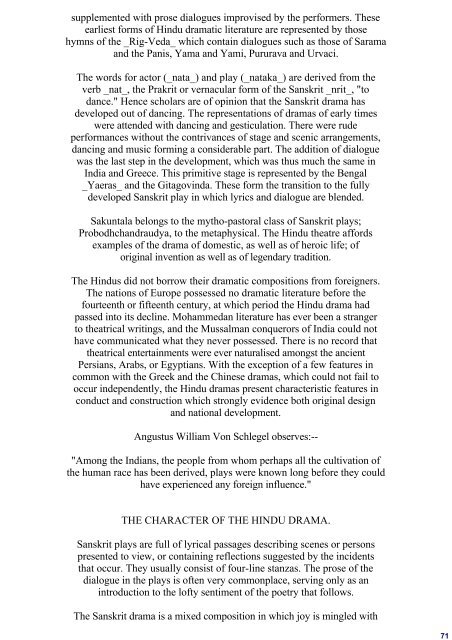TALES FROM THE HINDU DRAMATISTS - Awaken Video
TALES FROM THE HINDU DRAMATISTS - Awaken Video
TALES FROM THE HINDU DRAMATISTS - Awaken Video
Create successful ePaper yourself
Turn your PDF publications into a flip-book with our unique Google optimized e-Paper software.
supplemented with prose dialogues improvised by the performers. These<br />
earliest forms of Hindu dramatic literature are represented by those<br />
hymns of the _Rig-Veda_ which contain dialogues such as those of Sarama<br />
and the Panis, Yama and Yami, Pururava and Urvaci.<br />
The words for actor (_nata_) and play (_nataka_) are derived from the<br />
verb _nat_, the Prakrit or vernacular form of the Sanskrit _nrit_, "to<br />
dance." Hence scholars are of opinion that the Sanskrit drama has<br />
developed out of dancing. The representations of dramas of early times<br />
were attended with dancing and gesticulation. There were rude<br />
performances without the contrivances of stage and scenic arrangements,<br />
dancing and music forming a considerable part. The addition of dialogue<br />
was the last step in the development, which was thus much the same in<br />
India and Greece. This primitive stage is represented by the Bengal<br />
_Yaeras_ and the Gitagovinda. These form the transition to the fully<br />
developed Sanskrit play in which lyrics and dialogue are blended.<br />
Sakuntala belongs to the mytho-pastoral class of Sanskrit plays;<br />
Probodhchandraudya, to the metaphysical. The Hindu theatre affords<br />
examples of the drama of domestic, as well as of heroic life; of<br />
original invention as well as of legendary tradition.<br />
The Hindus did not borrow their dramatic compositions from foreigners.<br />
The nations of Europe possessed no dramatic literature before the<br />
fourteenth or fifteenth century, at which period the Hindu drama had<br />
passed into its decline. Mohammedan literature has ever been a stranger<br />
to theatrical writings, and the Mussalman conquerors of India could not<br />
have communicated what they never possessed. There is no record that<br />
theatrical entertainments were ever naturalised amongst the ancient<br />
Persians, Arabs, or Egyptians. With the exception of a few features in<br />
common with the Greek and the Chinese dramas, which could not fail to<br />
occur independently, the Hindu dramas present characteristic features in<br />
conduct and construction which strongly evidence both original design<br />
and national development.<br />
Angustus William Von Schlegel observes:--<br />
"Among the Indians, the people from whom perhaps all the cultivation of<br />
the human race has been derived, plays were known long before they could<br />
have experienced any foreign influence."<br />
<strong>THE</strong> CHARACTER OF <strong>THE</strong> <strong>HINDU</strong> DRAMA.<br />
Sanskrit plays are full of lyrical passages describing scenes or persons<br />
presented to view, or containing reflections suggested by the incidents<br />
that occur. They usually consist of four-line stanzas. The prose of the<br />
dialogue in the plays is often very commonplace, serving only as an<br />
introduction to the lofty sentiment of the poetry that follows.<br />
The Sanskrit drama is a mixed composition in which joy is mingled with<br />
71
















